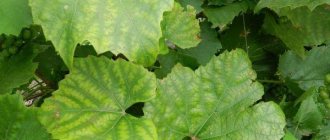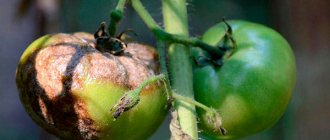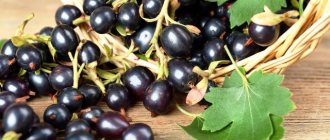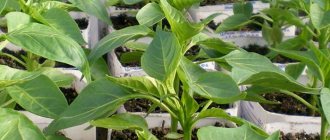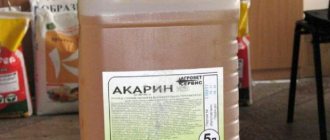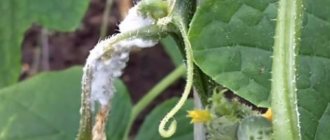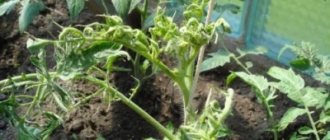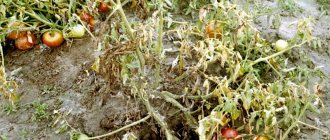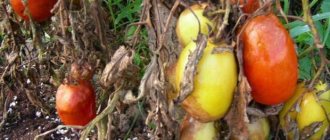Fungal diseases of cherries
Cherry diseases and their control are very difficult for gardeners. With the wrong approach to treatment, you can lose not only the current year’s harvest, but also the tree itself. Therefore, it is important to understand what kind of disease the cherry tree suffers from. Fungal diseases of stone fruits are especially common:
- Clusterosporiosis of cherry
The fungus primarily affects the leaves; brownish spots first cover the surface and then corrode the leaf tissue, pockmarking it with small holes. Therefore, clusterosporiosis has a second name - cherry hole spot. Branches, buds, and flowers are also susceptible to fungal infection.
Cherry clasterosporiasis - pictured
How to fight? Remove diseased leaves and regularly dig up the soil around the trunk. Treat all damage to the bark with 1% copper sulfate. At the beginning of the season, before the leaves appear, treat the tree and the ground around it again.
As soon as the buds begin to open, treat with Bordeaux mixture at the rate of 100 grams of the substance per bucket of water. Spray the crown the second time after flowering, the third time after another couple of weeks, and the fourth time after harvesting the berries.
- Cherry coccomycosis
This disease is also called reddish-brown spotting; during the flowering period, the leaves become covered with red dots, and pink pollen is visible on their underside; the foliage turns yellow and crumbles.
Cherry coccomycosis - pictured
How to fight? Before the flowers bloom, treat the crown with iron sulfate (300 g per bucket of water), and after flowering, spray with Horus (2 g per bucket of water). Repeat the Horus treatment after two to three weeks, and at the end of the harvest, spray again. Plant varieties that are more resistant to coccomycosis, such as Fatezh cherries. And, here, Valery Chkalov’s cherries are not very resistant to the disease, but the fruits are very tasty.
- Moniliosis, or gray rot
The appearance of gray rot on cherries looks like a burn on the leaves - they darken and dry out, as if scorched. Monilial burn also affects cherry fruits; grayish growths appear on them, the berries rot and fall off.
Cherry moniliosis - pictured
gray rot of cherries - in the photo
How to fight? Diseased tissue should be removed and burned. Harmful insects - caterpillars and weevils - carry the fungus, so they also need to be controlled with the help of insecticides. In the spring, as well as at the end of flowering, spray the trees and the ground around them with 1% Bordeaux mixture, and repeat disinfection at the end of flowering. Trees are also whitewashed in the fall for disinfection.
- Verticillium wilt, cherry wilt
The name of a fungal disease that appears in early spring, usually on young trees. If the bark of a cherry tree breaks, it is most likely verticillium. The flowers darken and wither, gum appears on the branches and trunk, the bark peels off, and tissue necrosis occurs. The younger the tree, the faster the disease progresses. The death of a plant younger than seven years old can occur within a year, for older ones - in three to eight years.
verticillium wilt of cherries - pictured
How to fight? Try not to damage the roots when digging, as the fungus enters the wound from the soil and rises through the capillary vessels. In the spring, before the leaves appear, spray the crowns with cuproxate or 3% Bordeaux mixture.
And when the foliage blooms, treat with a 1% solution several more times: after flowering, after another couple of weeks, then at the end of summer and the last time in October, before the leaves begin to fall. If the infection does not subside, use stronger drugs against verticillium wilt - Polycarbacin, Fundazol, Topsin, Vectra, polychrome.
gum on cherries - in the photo
Thoroughly clean the cracks from which gum flows and cover them with mullein and clay mixed with 2% copper sulfate. Cover stumps from cut diseased branches with garden varnish or oil paint. Verticillium wilt often occurs in sunny and frosty areas, so in the fall, whiten the trunks with a solution of lime with the addition of copper sulfate.
Fungal diseases of cherries and the fight against them are not limited to the above options; they also include phyllosticosis - brown spot, powdery mildew, scab, cylindrosporiosis - white rust, most of which can be controlled with fungicides. Real mushrooms also settle on the trunk of the cherry tree - sulfur-yellow tinder fungus, false tinder fungus. To prevent their occurrence, repair all damage to the bark in a timely manner.
Cherry aphid
Aphid larvae settle on young leaves and feed on their sap. As a result, the leaves dry out and fall off prematurely. Severe aphid damage can lead to plant death.
Control measures:
- Damaged cherries are treated with infusions of dandelion, marigold, tobacco or tomato tops.
- 2 weeks after flowering, treat with a soap solution with the addition of ash: 0.5 kg of ash is poured into 3 liters of boiling water, left for a day, 1 tbsp is added. tar soap, stir, add 5 liters of water, filter, then pour in 2 tbsp. 9% vinegar.
- You can also use chemicals: in the “green cone” phase - Iskra or Inta-vir, immediately after flowering - Bi-58, Kinmiks, Decis. All treatments must be completed 1-1.5 months before harvesting the fruits.
Bacteriosis, or cherry cancer
If a cherry seedling dries out, it may be suffering from bacteriosis, this is a very dangerous bacterial disease that usually affects young cherry trees from three to eight years old.
Cherry bacteriosis - in the photo
Bacteria are transmitted by airborne droplets, settle in tree buds and penetrate the vessels of the plant. The bark becomes covered with ulcers, from which gum flows. Fruits and leaves become spotted and die. Cold spring promotes activation of the disease.
How to fight? Unfortunately, no effective methods have been developed to combat bacteriosis. But warm, dry weather prevents its development. Nitrogen fertilizers strengthen plants and increase resistance to disease. In addition, different cherry varieties have different degrees of resistance to the disease. Cherries, the health benefits and harms of which are not known to everyone, require proper care to obtain tasty and juicy berries.
Pest Control
Diseases are not the only thing that can ruin a harvest. These are cherry pests.
It is very important to get rid of unexpected guests, otherwise in just an hour the “bird cherry” harvest will disappear from the garden. It is necessary to install various repellers on trees and in the garden: stuffed animals, mirrors, garlands - anything that will scare away birds. But this is a temporary salvation, the birds will return. Only a fine mesh draped over a tree can really help.
Getting rid of aphids, moths and flies
The cherry aphid is a black, shiny pest. Their eggs remain on young shoots. In the spring they hatch, occupying the tops, leaves and stalks, from where they suck out all the juice. The leaves turn black, dry out and fall off. In order to get rid of this pest, you need to use a decoction of tree resin. The use of pesticides is also excellent. Spraying should be done immediately after the first insects appear.
Cherry shoot moth is a very small pest that is difficult to find on a tree. It overwinters in the bark. Due to the appearance of this pest, the tree grows slowly and slowly dies.
In order to avoid cherry moths, you need to dig up the soil and pull out all the caterpillars. Then treat with Karbofos and Iskra solution.
Cherry fly - found in absolutely all regions and can destroy almost the entire crop.
For prevention, it is necessary to bury all spoiled berries deeply. You also need to distract the flies with sweet ribbons so that they do not reach the cherries. You still need to treat with insecticides.
Weevils and moths are dangerous pests
The weevil is a small pest that is considered very dangerous. It eats away the bud, which leads to damage to the berry. To avoid consequences, you need to dig up the soil in the fall, get rid of rotten fruits, and fertilize in time. Be sure to collect beetles and burn them. Insecticide treatment must be carried out.
The winter moth is a pest that flies from the forest. These are yellow-green caterpillars that feed on both leaves and other parts of cherries. The most important thing is that they produce butterflies that are resistant to frost.
In the fall, it is advisable to dig up the soil to get rid of butterflies and caterpillars; the bark must be cleared of moss.
Every garden must be protected from any exposure to pests or diseases. It is best to carry out preventive measures in the garden, then there will be no need to fight diseases or pests. You cannot feel sorry for already dying trees; if necessary, you must uproot them and burn them. Otherwise, you risk healthy cherries.
Gommoz
Gommosis, or gum bleeding, is observed not only in cherries, but also in all stone fruit trees. On trunks and branches, even on fruits and foliage, there are often streaks of a thick viscous substance similar to resin - gum.
gum deposition of cherries - in the photo
Excessive production of gum indicates a problem with the plant. The reasons may be different: wounds, frost damage, excess nitrogen fertilizers, fungal diseases and pests, treatment with growth regulators and phytohormones. Therefore, it is necessary to find out what caused the excess secretion of gum.
How to fight? The wood in the place where the gum is released must be cut away to a healthy layer, and then the wound must be treated with copper sulfate and covered with garden varnish.
How to treat cherries - prevention
When and with what to spray cherries The first spring preventive treatment of cherries should be carried out before the sap begins to flow. The cherries are first trimmed, the sections are treated with a one percent solution of copper sulfate, followed by covering large wounds with garden pitch.
Don't forget to whitewash the trunks and skeletal branches with lime. Then dissolve 700 g of urea in ten liters of water and spray the cherries and tree trunk circles around the trunks. Urea will protect trees from wintering pests in their bark and in the soil around the tree trunk, destroy pathogens of fungal and infectious diseases, and also supply the cherries with the nitrogen necessary for the development of green mass.
If you are late and the cherry buds have already begun to swell, urea can cause them to burn, so treat the trees instead:
- nitrafen,
- fitaverm,
- acarin,
- agravertine or another drug with a similar effect.
At the same time, treat the cherry with Zircon or Ecoberin to increase its resistance to disease and weather disasters.
In the fall, after the leaves have fallen, carry out sanitary pruning of the branches, followed by treating cuts, wounds and cracks with copper sulfate, and then with garden varnish. Collect all plant remains along with fallen leaves and burn them. After the first frost, treat the cherries and soil under the crown with a five percent urea solution.
Chlorosis
Cherry chlorosis - many trees growing on soil saturated with chalk and limestone suffer from chlorosis. The proximity of groundwater also provokes chlorosis. Plants do not receive enough minerals and synthesize chlorophyll poorly. This can lead to a delay in their development, deterioration of fruiting, decreased productivity and even death. Sweet cherries are highly prone to chlorosis. If you notice that the leaves are turning lighter, especially on young specimens, this may be a sign of illness.
How to fight? Treatment of chlorosis is associated, first of all, with ensuring the functioning of the root system. It is recommended to water stone fruits with water with a minimum content of carbonates and salts - chlorides and sulfates. Oxygen exchange in the roots is improved by potassium permanganate; a solution in a proportion of 30 grams per bucket of water is watered on the tree, the soil under which has been previously moistened and loosened.
Fresh manure, superphosphate, and excess potassium fertilizers contribute to the development of chlorosis. It is useful to apply nitrogen fertilizers. Reduces chlorosis by adding compost, humus, and peat to the soil. Two or three times a year you can apply them at a rate of 5 kg per square meter. When watering, it is recommended to add bird droppings diluted ten times from time to time.
In early spring, before the leaves appear, spray the trees with iron sulfate in a proportion of 300 grams per bucket of water. Later, at the beginning of summer, also carry out two or three treatments with an interval of 10 days, but in a lower concentration, 50 g per bucket of water is enough. Make sure the solution does not leave any burns on the leaves. If this happens, dilute the solution.
In the fall, apply iron sulfate under the trees, mixing it with soil, humus or compost, then water the tree trunks generously. Now you know what the main cherry diseases are and how to combat them. Like any disease, it is always easier to prevent than to get rid of them.
How to feed cherries
The first spring treatment of cherries and tree trunks with urea is complex. It provides protection from pests and diseases, and feeds with nitrates at the same time. During flowering, you can fertilize the cherry tree with liquid chicken droppings, but this is not necessary.
After flowering, manure is added to the tree trunk circle for digging or in the form of a solution. You can also use dry nutrient organic mixtures in accordance with the manufacturer's instructions. If there is no rain during this period, then it is better to carry out liquid fertilizing.
In the summer, foliar spraying of cherries with nitrogen-containing preparations is carried out two or three times: the first - in mid-July, and then no earlier than three weeks later. If you find that the cherry is deficient in any element, apply foliar feeding with a preparation containing it. After fruiting, fertilize the tree trunk circle with compost, rotted manure or other organic matter.
Autumn feeding should include mineral compositions of calcium, potassium and phosphorus. During the same period, liming of insufficiently acidic soil is carried out. After the first frost, apply potassium-phosphorus fertilizers to the tree trunk circle under digging to a depth of 8 cm.
